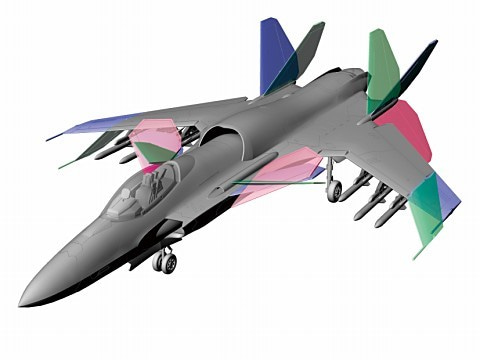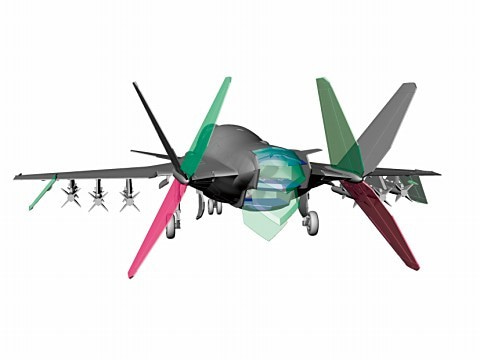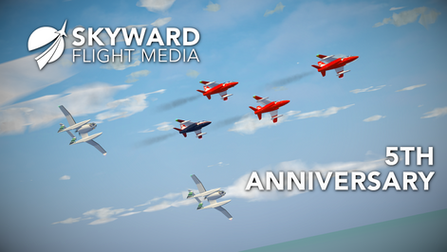A Unique Design That Has Survived Eras of Change

ORIGINAL POST: 14/11/2020 | UPDATE: 11/05/2024
With the release of the 25th Anniversary downloadable content on October 28th, 2020, Ace Combat 7: Skies Unknown added three more original aircraft to its roster: the ASF-X Shinden II, CFA-44 Nosferatu and the XFA-27. Like the other three original aircraft added in May, June and July of 2019, these aircraft come from past Ace Combat titles.
Even among the dozens of fictional aircraft that have appeared in the Ace Combat series since 1995, the Advanced Support Fighter Experimental (ASF-X) Shinden II (Japanese: 震電Ⅱ, English Translation: Magnificent Lightning II) has a unique place in the entirety of the Ace Combat series. Its real world design concept, mechanical designer, development history, lore and appearances across the three continuities of Ace Combat truly make it stand out.
Concept and Key Design Features
Though this aircraft was introduced on October 25th, 2011 as downloadable content for Ace Combat: Assault Horizon, the real world reasoning behind its design concept was divulged only during the Gamescom 2020 Ace Combat 7: Skies Unknown DLC Overview video.
As discussed by Ace Combat Brand Director Kazutoki Kono, when the ASF-X Shinden II was being designed for Ace Combat: Assault Horizon (2011), the nation of Japan was not yet confirmed for the purchase of the F-35 Joint Strike Fighter. The concept behind designing the ASF-X was to create an aircraft that could realistically fulfill the role of Japan’s first state-of-the-art stealth fighter for the defense of its national borders while maintaining a degree of playfulness.

To design this aircraft, the Project Aces development team worked with Shōji Kawamori as the supervisor of the mechanical design. A world famous Japanese anime creator and producer, screenwriter, visual artist, and mecha designer, Kawamori was a first for Ace Combat as a whole. All original designed aircraft come from the Project Aces team and not individuals outside of the team. Kawamori’s past mechanical designs include the Macross series, in which robots can transform into fighter jets. So naturally the ASF-X Shinden II adopted a so-called “Kawamori-ism” type of transformation to its design.

Example of flight surface 'transformation'.
Its forward swept wing, vertical stabilizers, horizontal stabilizers and canards incorporated variable wing geometry. These flight control surfaces can be shifted into three configurations. Its normal configuration (blue), cruise configuration for high speed flight (green) and landing/low speed flight configuration (red).
During its design phase, a primary concern Kawamori had was incorporating a vertical takeoff ability. Much of this was explained in the Aces At War 2011 interview Talk Dog Fight R01. The goal was to avoid using a large F-35B style lift-fan that would take up too much internal space. Though, seaborne operations were also considered, meaning that a twin-engine design was preferred. This resulted in an over/under engine design, similar to what is seen on the BAE English Electric Lightning. Having both engines in the standard side-by-side configuration would make VTOL difficult because of center of mass related issues, having the engines vertically stacked alleviates those problems.

Furthermore the driveshafts were offset forward and backward, VTOL engine nozzles capable of directing thrust 90 degrees downward were installed on the engines and exhaust slits for the forward engine duct fan were positioned on the underside of the fuselage beneath the canards to equalize lifting forces beneath the aircraft. With the flaps lowered and the wingtips, tail section and canards rotated downward, the aircraft would then envelope its engine exhaust and utilize ground effect as much as possible while thrust is vectored downward and the aircraft begins to generate lift.

Product of Attempted ‘Rebirth’
The ASF-X Shinden II was released at one of the most unusual times in Ace Combat history. Ace Combat: Assault Horizon was touted as the rebirth of the series, steering everything towards a real world Earth setting. Referred to as the Assault Horizon continuity, this break away from the longstanding fictional setting of Strangereal, the original Ace Combat world setting, had a mixed-reception from its established user base.
Introducing a fictional aircraft to a real world setting was an unusual choice in 2011, though the explanation of its design concept in 2020 clears that up a bit. However, the plans for the ASF-X Shinden II went well beyond just being a downloadable aircraft for a game. The amount of support the Shinden II recieved is actually rather unusual during this time period.
In support of the Assault Horizon continuity, the testing and development program of the Shinden II was the central focus of the novel Ace Combat: Ikaros in the Sky. That story introduced its test pilots, technical staff, the state the world was in when development began, and the politics related to the project. While further technical information is found in the Setting and Material sections of Ikaros, the next book from this era of Ace Combat went even farther.


Ace Combat: Assault Horizon Master File (March 2012) provided the most detailed and expansive look at a single aircraft from Ace Combat as of the time of this article’s release. Though the Aces at War 2011 and 2019 books are filled with a few pages of lore for other original, fictional aircraft designed by Project Aces, this 128 page master file was dedicated to the ASF-X Shinden and its eventual mass produced F-3 variants. Within its pages are development timelines, aircraft design explanation, weapons descriptions, aircraft system explanations, information on the export version for the Royal Navy and backstory on events not seen or mentioned in the 2011 video game or in Ace Combat: Ikaros in the Sky. Some of these events include brief armed conflicts with hostile factions seen in Ace Combat: Assault Horizon.
Despite the wealth of information to support the new direction of the Ace Combat series being lead by Ace Combat: Assault Horizon, the characters, world setting and timeline of the attempted rebirth of the series was done away with and never developed further after 2013.
The Shinden II Survives
The life of the Shinden II continued on well after Assault Horizon’s franchise reboot failure. As it was an aircraft introduced in that game and desigined specificallly for the attempted reboot of the Ace Combat series, it had a very real chance of being set aside, like the entire Assault Horizon era was.
Its next brief and unusual appearance was as a background aircraft in Mach Storm, an arcade cabinet, on-rails shooter that reused many Ace Combat assets.
It appeared in a highly visible role in Ace Combat Infinity (2014 - 2018) which introduced another spin-off continuity for Ace Combat as a whole. Flown by an allied but rival squadron to the players known as the Ridgebacks. The ASF-X Shinden did not have the same amount of backstory or spotlight within Ace Combat Infinity, but its presence was well known.

One of the strongest connections that kept the ASF-X relevant was its association to the pseudo mascot of Ace Combat that has appeared in multiple games and in various ways, Kei Nagase. In both the Ikaros in the Sky novel and in Ace Combat Infinity, Kei Nagase piloted this aircraft. There is also official media (pictures, desktop wallpapers, aircraft model kits) that connect this aircraft and the character.
The addition of the Shinden II to Ace Combat 7: Skies Unknown as a downloadable content aircraft brings it back with modern, high definition graphics. It does not play a central role to the story nor is it flown by a notable character, but its inclusion makes the Shinden one of two aircraft that appeared in all three Ace Combat continuities.
Notable Flight Characteristics
As Ace Combat has never incorporated VTOL controls into its flight model since 1995, the aircraft’s on-paper vertical lift capabilities are not available to players. But it can utilize an interesting slow speed flight characteristics that only a handful of Ace Combat aircraft can access. This seems to have been done by the Project Aces development team in lieu of full VTOL controls.

In Ace Combat: Assault Horizon, its VTOL ability inspired a maneuver for that game’s Close Range Assault system. While the Shinden II is being pursued in Dog Fight Mode, the nose of the aircraft pitches upward to begin a vertical loop. Within seconds of the maneuver starting the thrust vectored nozzles push the nose forward, cancelling the loop and positioning itself behind its pursuer. It is something similar to a mix of the Pugachev Cobra and Harrier VIFFing techniques combined. Though this maneuver cannot be recreated outside of Assault Horizon, it is an example of its unique flight abilities.
Its adaptability was emphasized in an unexpected stint of combat during an endurance test flight described in the novel Ace Combat: Ikaros in the Sky. One of the aircraft lost its left wing near the wing root during combat, but its advanced fly-by-light flight control system and variable geometry design was able to compensate. The damaged aircraft was able to recover from the wing loss, provide support in the fight and land safely.

With its namesake inspired by the Kyushu J7W Shinden, lightning has struck more than twice for the Advanced Support Fighter Experimental. It has solidified its presence in the now over two decade year old Ace Combat series in ways many of its contemporary and forerunner original design aircraft have not.
About the Writer
Aaron "Ribbon-Blue" Mendoza

Co-founder of Skyward Flight Media. After founding Electrosphere.info, the first English Ace Combat database, he has been involved in creating flight game-related websites, communities, and events since 2005. He explores past and present flight games and simulators with his extensive collection of game consoles and computers. Read Staff Profile.
SOURCES
[01] Timestamp: 0:56 - 4:07, Ace Combat 7: Skies Unknown DLC Overview | gamescom 2020; information about the Shinden II being designed with Japan not cleared to purchase the F-35 Joint Strike Fighter. A “degree of playfulness” mentioned.
[02] Project Nagase Blog Post 2012-05-30 03:00:00; aircraft wing configuration diagrams.
[03] Aces at War 2011: Talk Dog Fight R01, Pages 72, 73 and 74. Shoji Kawamori discussing the design concept, VTOL capability and unique Ace Combat: Assault Horizon counter maneuver.
[04] Ace Combat: Ikaros in the Sky; information about design, wing loss in combat information, ties to Kei Nagase, source of Shinden II namesake tied to Kyushu J7W.
[05] Ace Combat: Assault Horizon; gameplay proof of slow speed flight characteristics, release date of DLC, unique counter maneuver described by Shoji Kawamori.
[06] Ace Combat: Assault Horizon Master File: discusses of mass production version of ASF-X Shinden II, other events and conflicts from the Assault Horizon universe.
[07] Mach Storm; aircraft seen on aircraft carrier deck before each level/mission.


























.png)